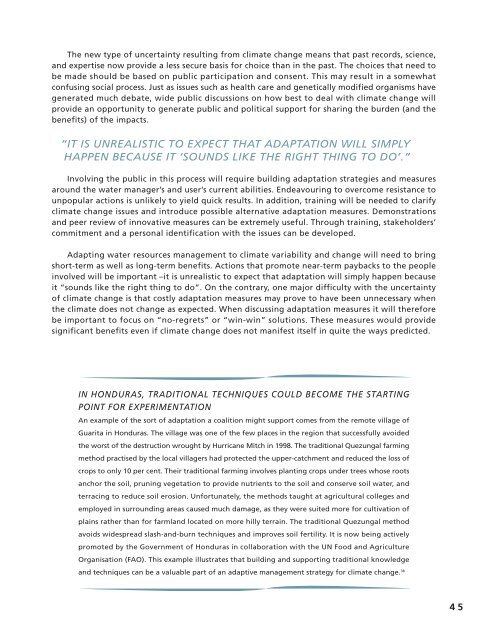Adaptation of water resources management to climate change
Adaptation of water resources management to climate change
Adaptation of water resources management to climate change
Create successful ePaper yourself
Turn your PDF publications into a flip-book with our unique Google optimized e-Paper software.
The new type <strong>of</strong> uncertainty resulting from <strong>climate</strong> <strong>change</strong> means that past records, science,and expertise now provide a less secure basis for choice than in the past. The choices that need <strong>to</strong>be made should be based on public participation and consent. This may result in a somewhatconfusing social process. Just as issues such as health care and genetically modified organisms havegenerated much debate, wide public discussions on how best <strong>to</strong> deal with <strong>climate</strong> <strong>change</strong> willprovide an opportunity <strong>to</strong> generate public and political support for sharing the burden (and thebenefits) <strong>of</strong> the impacts.“IT IS UNREALISTIC TO EXPECT THAT ADAPTATION WILL SIMPLYHAPPEN BECAUSE IT ‘SOUNDS LIKE THE RIGHT THING TO DO’.”Involving the public in this process will require building adaptation strategies and measuresaround the <strong>water</strong> manager’s and user’s current abilities. Endeavouring <strong>to</strong> overcome resistance <strong>to</strong>unpopular actions is unlikely <strong>to</strong> yield quick results. In addition, training will be needed <strong>to</strong> clarify<strong>climate</strong> <strong>change</strong> issues and introduce possible alternative adaptation measures. Demonstrationsand peer review <strong>of</strong> innovative measures can be extremely useful. Through training, stakeholders’commitment and a personal identification with the issues can be developed.Adapting <strong>water</strong> <strong>resources</strong> <strong>management</strong> <strong>to</strong> <strong>climate</strong> variability and <strong>change</strong> will need <strong>to</strong> bringshort-term as well as long-term benefits. Actions that promote near-term paybacks <strong>to</strong> the peopleinvolved will be important –it is unrealistic <strong>to</strong> expect that adaptation will simply happen becauseit “sounds like the right thing <strong>to</strong> do”. On the contrary, one major difficulty with the uncertainty<strong>of</strong> <strong>climate</strong> <strong>change</strong> is that costly adaptation measures may prove <strong>to</strong> have been unnecessary whenthe <strong>climate</strong> does not <strong>change</strong> as expected. When discussing adaptation measures it will thereforebe important <strong>to</strong> focus on “no-regrets” or “win-win” solutions. These measures would providesignificant benefits even if <strong>climate</strong> <strong>change</strong> does not manifest itself in quite the ways predicted.IN HONDURAS, TRADITIONAL TECHNIQUES COULD BECOME THE STARTINGPOINT FOR EXPERIMENTATIONAn example <strong>of</strong> the sort <strong>of</strong> adaptation a coalition might support comes from the remote village <strong>of</strong>Guarita in Honduras. The village was one <strong>of</strong> the few places in the region that successfully avoidedthe worst <strong>of</strong> the destruction wrought by Hurricane Mitch in 1998. The traditional Quezungal farmingmethod practised by the local villagers had protected the upper-catchment and reduced the loss <strong>of</strong>crops <strong>to</strong> only 10 per cent. Their traditional farming involves planting crops under trees whose rootsanchor the soil, pruning vegetation <strong>to</strong> provide nutrients <strong>to</strong> the soil and conserve soil <strong>water</strong>, andterracing <strong>to</strong> reduce soil erosion. Unfortunately, the methods taught at agricultural colleges andemployed in surrounding areas caused much damage, as they were suited more for cultivation <strong>of</strong>plains rather than for farmland located on more hilly terrain. The traditional Quezungal methodavoids widespread slash-and-burn techniques and improves soil fertility. It is now being activelypromoted by the Government <strong>of</strong> Honduras in collaboration with the UN Food and AgricultureOrganisation (FAO). This example illustrates that building and supporting traditional knowledgeand techniques can be a valuable part <strong>of</strong> an adaptive <strong>management</strong> strategy for <strong>climate</strong> <strong>change</strong>. 3845











![View full document [PDF 988.55 KB] - PreventionWeb](https://img.yumpu.com/47733942/1/184x260/view-full-document-pdf-98855-kb-preventionweb.jpg?quality=85)
![View full document (in French) [PDF 4.96 MB] - PreventionWeb](https://img.yumpu.com/47223870/1/184x260/view-full-document-in-french-pdf-496-mb-preventionweb.jpg?quality=85)


![View full document [PDF 25.02 MB] - PreventionWeb](https://img.yumpu.com/44204570/1/190x234/view-full-document-pdf-2502-mb-preventionweb.jpg?quality=85)
